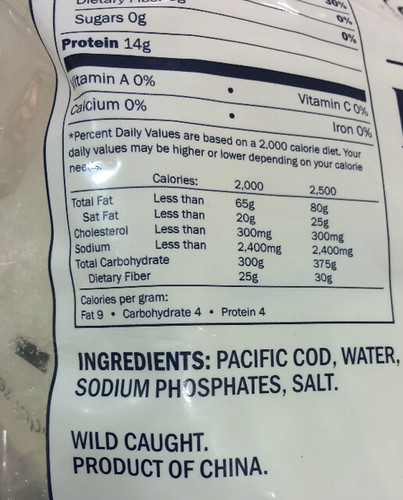
How can fish in a grocery store be labeled as both “Alaskan” and “Product of China” on the same package? The answer is that although much of the seafood sold in the United States is labeled with a foreign country of origin, some of that same seafood was actually caught in U.S. waters.
Under the Country of Origin Labeling program regulations – enforced by USDA’s Agricultural Marketing Service – when fish are caught in U.S. waters and then processed in a foreign country that foreign country of processing must appear on the package as the country of origin. This processing usually takes the form of filleting and packaging the fish into the cuts you see in the grocery store seafood department or frozen food aisle. However, if the fish was actually caught in Alaskan waters, retailers are also able to promote the Alaskan waters the fish was actually caught in, in addition to the country in which the processing occurred.
An example of this would be when a wild cod is caught off the coast of Alaska and, due to economic factors, is shipped to another country to be fabricated into fillets and packaged. If this process of turning a whole fish into packaged fillets occurs in China, the cod fillets are declared “Wild Caught Product of China” upon import into the United States. However, if the importer can demonstrate that the cod was caught in Alaskan waters, the packaged cod fillets are also eligible to say “Alaskan”.
The Country of Origin Labeling regulations require most grocery stores to provide the country of origin for fish and shellfish, and the method of production (farm-raised or wild-caught), at the point of sale where consumers make purchasing decisions. Suppliers to retailers, including distributors, repackers, processing facilities, harvesters, and importers, are also required to convey this Country of Origin Labeling information to their subsequent buyers.
The Country of Origin Labeling program, in close partnership with many State and Federal agencies, assesses labeling compliance in grocery store locations across the United States every year. In addition, the Country of Origin Labeling program audits the supply chain to verify the accuracy of country of origin and method of production declarations.
Not only are seafood labels checked for mandatory country of origin labeling declarations, but much of the fruits and vegetables, peanuts, pecans, macadamia nuts, ginseng, lamb, goat, and chicken at your local grocery store must also include country of origin information. For more information about the mandatory Country of Origin Labeling program, visit: www.ams.usda.gov/cool.



